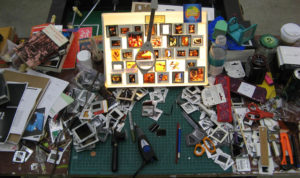Chapter 3 of potential hindrances to our creative development:
**00III: You need to know the rules before you break them**
I hesitate to corral this chapter as I am very aware of so much of its extensive complexity that I have left untouched. It’s pretty easy to get fogged in with the specifics so I’m going to stick to my inclination to bring something from below the surface to be gently laid out as a field so that it may be viewed as an expanse with indeterminable margins.
If we consider the world as a complex field of interconnectedness or interrelatedness and we want to create/identify things to think and talk about, we need to introduce a model of order. To channel the creative force in a way that we become aware of it, we might adopt a discipline but the discipline itself does not guarantee the manifestation of the creative energy. It only provides the frame for the creative energy to be experienced (felt or thought about). It is a construct that is a window or a door to invite the flow in; not to confine, pin down, master or predict. The creative energy does not bend to our will nor is it necessarily controlled by the skills or techniques we have acquired.

A glimpse of my studio at some point.
If I had to say how I personally tap my creative stream— I simply do what gives me the most pleasure. This involves curiosity, wonder, spontaneity, nonsense, sincerity, goofing around, contemplation…collecting and handling a bunch of knickity-knacks and trinkets, wandering about aimlessly, putting things together…It might be work but it’s never labour. And any structure I attempt to assemble is just a flimsy raft to get out on the water. I’m just riding a momentum (hence the term ‘flow’) so there is an ease to it that makes me forget to eat and hydrate. It reminds me of a scene in the 2009 film, Bright Star, where John Keats attempts to express why poetry cannot be taught and says,
“The point of diving in a lake is not immediately to swim to shore, but to be in the lake; to luxuriate in the sensation of water. You do not work the lake out. It is an experience beyond thought. Poetry soothes and emboldens the soul to accept mystery.”
When we take into account the presupposition ‘you need to know the rules before you break them’, we are really talking about conventions. This statement is a snag in a creative sphere when it is laid out as a fixed, uniform, and universal (cause and effect) approach to something unfixed and unique that does not adhere to a universal criteria (or causality). So-called ‘art projects’ given with a set theme, strict steps and expectations that begin with a preview of demonstrated results, may not leave much space for the complexity of the creative impulse. French-American artist, writer and chess-player, Marcel Duchamp, once commented on artists being content to make do with tradition: 
“Well, then, they go on with it, but when they are ready to be themselves, things hold
them down in spite of themselves. The education is so strong in every child. It holds them like a chain. That’s what I wanted to avoid, and yet I didn’t completely get free. But I tried to, consciously. I unlearned to draw. I actually had to forget with my hand.”
As I’ve brought up throughout this chapter, conventions in the form of skills, techniques, timing, process etc. can be quite useful so long as we keep them at arms length and recognize them as merely interpretations of the infinitely changing. There are just too many nuances to apply final conclusions. As Irish playwright (George) Bernard Shaw put it in Man and Superman, “The golden rule is that there are no golden rules.” When we freely choose, give in to, utilize, and dabble with existing ideas and maintain the attitude that they are a temporary stand in, they offer us something to hold onto and ultimately let go of to allow fluid receptive states of unhinged creative expression. Like swinging from vine to vine until we drop into a pool of infinite possibility.
To sort through some of the mist around all this for yourself, I have drafted out 2 incomplete collections of questions that might offer a sense of an expanding or deflating relationship with rules:


It’s easy to take all of this way too seriously. No amount of wordy explanations will ever lead us into the nature of our own selves. The more we explain, the further it runs away from us. It is like trying to get a grip on a cloud or our own shadow. Asking where love comes from isn’t going to show us how to love. We keep hoping for certainty when there is none. But don’t worry, if you know that you do not understand then you truly understand.
Boxing was nothing. It wasn’t important at all. Boxing was just a means
to introduce me to the world.
-MUHAMMAD ALI
*the above Muhammad Ali image is from 1977- the late boxer gave John Stewart worldwide exclusivity of his portrait for one year — rights that Stewart eventually sold to his friend Andy Warhol.
